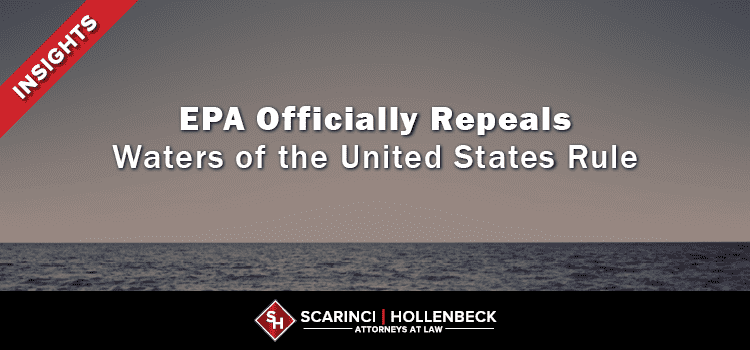
Daniel T. McKillop
Partner
201-896-7115 dmckillop@sh-law.comAuthor: Daniel T. McKillop|September 25, 2019
On September 12, 2019, the Environmental Protection Agency (EPA) and the Department of the Army formally repealed the Obama-era “Waters of the United States” rule (“2015 WOTUS Rule”) and restored the regulatory text that existed prior to the 2015 Rule. While the changes will benefit developers and regulated industries, environmental groups have already vowed to challenge the repeal in court.

“Today, EPA and the Department of the Army finalized a rule to repeal the previous administration’s overreach in the federal regulation of U.S. waters and recodify the longstanding and familiar regulatory text that previously existed,” EPA Administrator Andrew Wheeler said in a press statement. “Today’s Step 1 action fulfills a key promise of President Trump and sets the stage for Step 2 — a new WOTUS definition that will provide greater regulatory certainty for farmers, landowners, home builders, and developers nationwide.”
In 2015, the Obama Administration promulgated the “Clean Water Rule: Definition of ‘Waters of the United States’” to further define the “waters of the United States.” The rule adopted the approach of Justice Anthony Kennedy’s concurring opinion in Rapanos v. United States, 547 U.S. 715 (2006), defining the scope of jurisdictional waters as whether a water or wetland possesses a “‘significant nexus’ to waters that are or were navigable in fact or that could reasonably be so made.”
The broad standard set forth in the 2015 WOTUS Rule prompted significant litigation. As a result, the 2015 Rule applied in 22 states, the District of Columbia and the U.S. Territories, while the pre-existing regulations apply in more than half the states.
Upon taking office, President Donald Trump made it a priority to repeal the Obama-era rule and create a more restrictive definition. In a 2017 Executive Order, the Trump Administration called for interpreting the term “navigable waters” in a manner consistent with the opinion of Justice Antonin Scalia in Rapanos. In the Supreme Court’s split decision, Justice Scalia maintained that “the phrase ‘the waters of the United States’ includes only those relatively permanent, standing or continuously flowing bodies of water ‘forming geographic features’ that are described in ordinary parlance as ‘streams[,] . . . oceans, rivers, [and] lakes.’. . . . The phrase does not include channels through which water flows intermittently or ephemerally, or channels that periodically provide drainage for rainfall…”
The Executive Order also directed the EPA and the Department of the Army to review the 2015 Rule for consistency with the policy outlined in the order and to issue a proposed rule rescinding or revising the 2015 Rule as appropriate and consistent with law. As set forth in the final rule, the EPA and Army are repealing the 2015 WOTUS Rule for four reasons:
First, the agencies conclude that the 2015 Rule did not implement the legal limits on the scope of the agencies’ authority under the Clean Water Act (CWA) as intended by Congress and reflected in Supreme Court cases, including Justice Kennedy’s articulation of the significant nexus test in Rapanos. Second, the agencies conclude that in promulgating the 2015 Rule the agencies failed to adequately consider and accord due weight to the policy of the Congress in CWA section 101(b) to “recognize, preserve, and protect the primary responsibilities and rights of States to prevent, reduce, and eliminate pollution” and “to plan the development and use . . . of land and water resources.” 33 U.S.C. 1251(b). Third, the agencies repeal the 2015 Rule to avoid interpretations of the CWA that push the envelope of their constitutional and statutory authority absent a clear statement from Congress authorizing the encroachments of federal jurisdiction over traditional State land-use planning authority. Lastly, the agencies conclude that the 2015 Rule’s distance-based limitations suffered from certain procedural errors and a lack of adequate record support.
The new final rule will implement the pre-2015 regulations and will be effective 60 days after publication in the Federal Register. According to the agencies, they will “implement the pre-2015 Rule regulations informed by applicable agency guidance documents and consistent with Supreme Court decisions and longstanding agency practice.”
Repealing the 2015 WOTUS Rule is just one step of the rulemaking process. The next step is to approve a new definition of “waters of the United States.” In December 2018, EPA and the Army proposed a new definition. As discussed in greater detail in prior article, the new WOTUS definition significantly curtails the reach of the CWA.
Notably, under the proposed WOTUS definition, ephemeral features that contain water only during or in response to rainfall would not be a jurisdictional water under the CWA. This is significant given that an EPA study commissioned by the Obama Administration found that nearly 60 percent of all U.S. waterways, and 81 percent in the Southwest, are ephemeral or flow seasonally.
Adjacent wetlands are also treated differently. Under the agencies’ new proposal, wetlands must either abut jurisdictional waters or have a direct hydrological surface connection to jurisdictional waters in a typical year to be jurisdictional themselves. Wetlands physically separated from jurisdictional waters by a berm, dike, or other barrier are not adjacent if they lack a direct hydrologic surface connection to a jurisdictional water in a typical year.
While it may still be subject to additional revisions, and legal challenges will likely continue, the new WOTUS Rule will significantly impact a wide range of legal issues related to the CWA, including permitting, regulatory compliance and potential liability matters. We will continue to monitor the rulemaking and encourage entities impacted by the CWA to check back for updates.
If you have any questions or if you would like to discuss the matter further, please contact me, Dan McKillop, or the Scarinci Hollenbeck attorney with whom you work, at 201-806-3364.

Partner
201-896-7115 dmckillop@sh-law.comOn September 12, 2019, the Environmental Protection Agency (EPA) and the Department of the Army formally repealed the Obama-era “Waters of the United States” rule (“2015 WOTUS Rule”) and restored the regulatory text that existed prior to the 2015 Rule. While the changes will benefit developers and regulated industries, environmental groups have already vowed to challenge the repeal in court.

“Today, EPA and the Department of the Army finalized a rule to repeal the previous administration’s overreach in the federal regulation of U.S. waters and recodify the longstanding and familiar regulatory text that previously existed,” EPA Administrator Andrew Wheeler said in a press statement. “Today’s Step 1 action fulfills a key promise of President Trump and sets the stage for Step 2 — a new WOTUS definition that will provide greater regulatory certainty for farmers, landowners, home builders, and developers nationwide.”
In 2015, the Obama Administration promulgated the “Clean Water Rule: Definition of ‘Waters of the United States’” to further define the “waters of the United States.” The rule adopted the approach of Justice Anthony Kennedy’s concurring opinion in Rapanos v. United States, 547 U.S. 715 (2006), defining the scope of jurisdictional waters as whether a water or wetland possesses a “‘significant nexus’ to waters that are or were navigable in fact or that could reasonably be so made.”
The broad standard set forth in the 2015 WOTUS Rule prompted significant litigation. As a result, the 2015 Rule applied in 22 states, the District of Columbia and the U.S. Territories, while the pre-existing regulations apply in more than half the states.
Upon taking office, President Donald Trump made it a priority to repeal the Obama-era rule and create a more restrictive definition. In a 2017 Executive Order, the Trump Administration called for interpreting the term “navigable waters” in a manner consistent with the opinion of Justice Antonin Scalia in Rapanos. In the Supreme Court’s split decision, Justice Scalia maintained that “the phrase ‘the waters of the United States’ includes only those relatively permanent, standing or continuously flowing bodies of water ‘forming geographic features’ that are described in ordinary parlance as ‘streams[,] . . . oceans, rivers, [and] lakes.’. . . . The phrase does not include channels through which water flows intermittently or ephemerally, or channels that periodically provide drainage for rainfall…”
The Executive Order also directed the EPA and the Department of the Army to review the 2015 Rule for consistency with the policy outlined in the order and to issue a proposed rule rescinding or revising the 2015 Rule as appropriate and consistent with law. As set forth in the final rule, the EPA and Army are repealing the 2015 WOTUS Rule for four reasons:
First, the agencies conclude that the 2015 Rule did not implement the legal limits on the scope of the agencies’ authority under the Clean Water Act (CWA) as intended by Congress and reflected in Supreme Court cases, including Justice Kennedy’s articulation of the significant nexus test in Rapanos. Second, the agencies conclude that in promulgating the 2015 Rule the agencies failed to adequately consider and accord due weight to the policy of the Congress in CWA section 101(b) to “recognize, preserve, and protect the primary responsibilities and rights of States to prevent, reduce, and eliminate pollution” and “to plan the development and use . . . of land and water resources.” 33 U.S.C. 1251(b). Third, the agencies repeal the 2015 Rule to avoid interpretations of the CWA that push the envelope of their constitutional and statutory authority absent a clear statement from Congress authorizing the encroachments of federal jurisdiction over traditional State land-use planning authority. Lastly, the agencies conclude that the 2015 Rule’s distance-based limitations suffered from certain procedural errors and a lack of adequate record support.
The new final rule will implement the pre-2015 regulations and will be effective 60 days after publication in the Federal Register. According to the agencies, they will “implement the pre-2015 Rule regulations informed by applicable agency guidance documents and consistent with Supreme Court decisions and longstanding agency practice.”
Repealing the 2015 WOTUS Rule is just one step of the rulemaking process. The next step is to approve a new definition of “waters of the United States.” In December 2018, EPA and the Army proposed a new definition. As discussed in greater detail in prior article, the new WOTUS definition significantly curtails the reach of the CWA.
Notably, under the proposed WOTUS definition, ephemeral features that contain water only during or in response to rainfall would not be a jurisdictional water under the CWA. This is significant given that an EPA study commissioned by the Obama Administration found that nearly 60 percent of all U.S. waterways, and 81 percent in the Southwest, are ephemeral or flow seasonally.
Adjacent wetlands are also treated differently. Under the agencies’ new proposal, wetlands must either abut jurisdictional waters or have a direct hydrological surface connection to jurisdictional waters in a typical year to be jurisdictional themselves. Wetlands physically separated from jurisdictional waters by a berm, dike, or other barrier are not adjacent if they lack a direct hydrologic surface connection to a jurisdictional water in a typical year.
While it may still be subject to additional revisions, and legal challenges will likely continue, the new WOTUS Rule will significantly impact a wide range of legal issues related to the CWA, including permitting, regulatory compliance and potential liability matters. We will continue to monitor the rulemaking and encourage entities impacted by the CWA to check back for updates.
If you have any questions or if you would like to discuss the matter further, please contact me, Dan McKillop, or the Scarinci Hollenbeck attorney with whom you work, at 201-806-3364.